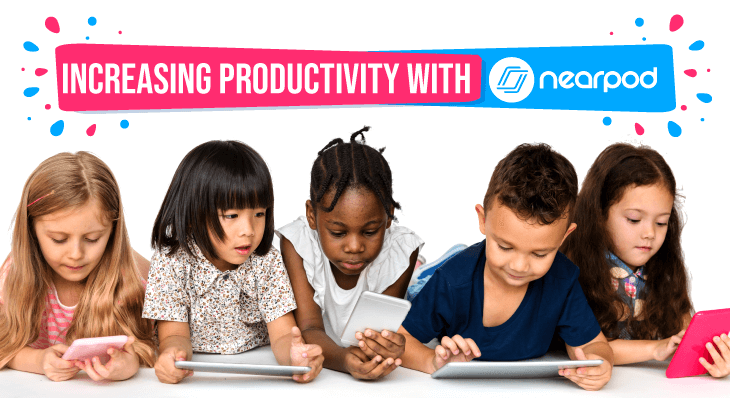
Increasing Productivity with Nearpod
How do you provide purposeful questioning to your students and shift from a sage on the stage to a guide on the side? Meagan and Chad, Classroom Technology Designers at Katy ISD share their expertise and key takeaways to manage your classroom devices.
What is Purposeful Questioning?
Manageable data, which you can receive through a variety of means, with purposeful questioning being one of those means. At the heart of purposeful questioning is planning. Do you know what you’re going to be asking your students in class the next day? Are you looking at formative information and dissecting their learning journey within each lesson? Did they retain what you taught? We should be using the formative questions practices as a guide for our instruction.
Here is some insight into chorus questioning versus purposeful questioning.

A common example of chorus questioning is a teacher sitting at the front of the classroom posing a question to the entire class. That teacher might receive a handful of answers. As teachers, it’s no secret that we have a lot of resources that we’re using at that moment to see who’s responding and who is not. Unfortunately, we’re not left with a lot of information at the end of the lesson.
If you as the teacher pose a question and a handful of students respond aloud are you able to easily decipher between the responses to filter the students that respond incorrectly? Do you notice how many kids don’t say anything at all? On some level, you as a teacher might have a gut feeling about your student’s level of understanding. But is that gut feeling valid? Is it a confirmation bias?
There are tons of interactive activities that Nearpod has available. As you’re going through your lesson, you can weave those activities in your lesson. At the end of your lesson, all of the data is ready for you.
Purposeful Questioning Takeaways:
- Plan your questioning and collect data.
- If it’s not planned and collected your data is of no use.
- Use data to drive future instruction.
- By doing this, we are not spending precious class time on material our class already knows. We are also ensuring success by not speeding past a topic that the kids are not fully understanding.
- Allow for all students to have a greater voice.
- With Nearpod, you’re actually hearing each and every student rather than the kids who are sitting in the back that would never have shared their thinking.
- Add activities in real time
- If a student asks a great question and you want to pose this to the entire class, you can add an activity in real time and collect that feedback instantly.
[click_to_tweet tweet=”Provide purposeful questioning to your class and shift from a sage on the stage to a guide on the side. ” quote=”Provide purposeful questioning to your class and shift from a sage on the stage to a guide on the side. “]
Shifting Roles from Presenter to Facilitator:
The lecture method is leaving us for the most part and we have to think about why. Why was the lecture method relevant in the first place? It was relevant because at the time, the only source of material was the instructor and we had to be the abrituror of all knowledge. Now, our students have supercomputers in their pockets. How much do we want to fight that supercomputer and how much do we want to embrace it? How much do we want to struggle against those attention spans and how much do we want to use them to our advantage?

We have heard concerns from teachers that they feel if they don’t say it, they’re afraid their students aren’t going to hear it.
[click_to_tweet tweet=”Just because you say it doesn’t mean they heard it, doesn’t mean you taught it and it doesn’t mean they learned it! – @ChadScott” quote=”Just because you say it doesn’t mean they heard it, doesn’t mean you taught it and it doesn’t mean they learned it! – @ChadScott”]
[click_to_tweet tweet=”If we’re no longer restricted by content delivery and the kids aren’t restricted by content consumption, what roles are we as teachers and them as students free to fulfill? – @MeaganLopez” quote=”If we’re no longer restricted by content delivery and the kids aren’t restricted by content consumption, what roles are we as teachers and them as students free to fulfill? – @MeaganLopez”]
For those that see this shift as scary and overwhelming, I encourage you to perceive this as freedom. You are not bound to those same expectations of spending time at the front of the classroom all day. If you’re delivering a stand-up lecture for 40 minutes a day each period, is your last class really receiving the best instruction from you?
It’s time to re-evaluate who is doing the most work in the classroom to ensure they are indeed learning the material you work so hard to prep!
Shifting Roles Takeaway
- Students drive learning
- Teacher facilitates and guides
- Requires planning
- More upfront work, less work in class!
- With Nearpod’s K-12 Lesson Library, it’s less work than you think!
Classroom Management
When you embrace your students love of devices, you’re teaching integrated digital citizenship which is a transferable skill.

Classroom Management Takeaway
If we work with, and not against student devices we can teach valuable life skills and increase productivity. This will also increase your scope of resources if used correctly.
More Increasing Productivity with Nearpod Information
Click here to watch the full video from Meagan and Chad.

Meagan Lopez and Chad Scott, Classroom technology designers at Katy ISD.

